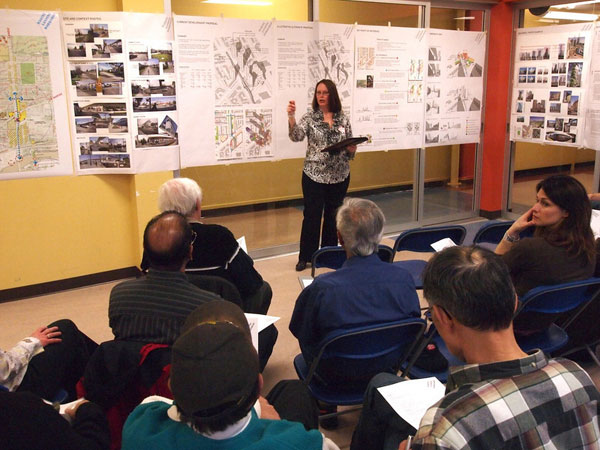Despite a rich history that goes back hundreds of years, Marpole is one of those places in the city that has managed to stay under the radar. Located along Vancouver’s south-western edge, it is currently home to a diverse residential community of young families, seniors, business professionals and newcomers to Canada.
While its reputation as a quiet, serene place has attracted many residents, it has also its downside. Decades of auto-oriented transportation infrastructure planning have not been kind to the the area, making it the only Vancouver neighbourhood disrupted by three major arterials – Granville St., Cambie St. and SW Marine Drive – as well as the most heavily trafficked road in the city, Oak Street. The heavy traffic volumes are intimately connected to the Oak Street and Arthur Laing bridges that connect Vancouverites to Richmond and beyond.
The creation of the Arthur Laing bridge (and the on-/off-ramps that support it), in particular, had a devastating effect on the neighbourhood – burying important First Nations sites under asphalt and severing the original European settlement of Eburne from any meaningful ties to the larger city.
All these relatively recent transformations have contributed to Marpole being more of a neighbourhood to pass through than visit and has lead many long-time residents to refer to it as a ‘forgotten community’ despite being an enjoyable place to live.
Jo-Anne Pringle is aiming to change this. A Vancouver native, Jo-Anne has lived in Marpole for just over 10 years altogether. Having lived near Granville and 71st in the early 1990’s, she took also lived for a short period of time in a condominium near Science World before moving back into the neighbourhood with her husband and two young children in 2004. As a result, she has witnessed both the benefits and drawbacks that density can bring to a community. Jo-Anne is also familiar with the development community, having worked for two high-profile development companies in Vancouver before starting her own business in 2006.
Jo-Anne isn’t your typical community activist, however. In fact, she eschews the word activist, preferring ‘engaged community member.’ She believes that not only is she a part of her Marpole community, but that the community is a part of her.
Like Jo-Anne, the Marpole Area Residents Alliance (MARA) isn’t your typical neighbourhood association. MARA was founded in June 2010 in reaction to the developments proposed at the intersection of SW Marine Drive and Cambie St. that were spurred by the construction of most recent addition to the Marpole’s infrastructural family, the Canada Line SkyTrain line. As she recalls, Jo-Anne met two other concerned residents at an open house for a rezoning application and recognizing that Marpole residents needed a voice in the process, they formed MARA on the spot.
Unlike many neighbourhood associations who take an ‘us vs. them’ attitude towards development, MARA is supportive of development and density in the community. Where other neighbourhoods would see storm clouds when developers arrive in their area, the alliance sees a silver lining. They recognize that the city is changing. So, rather than looking at the coming developments as another tear in their community fabric, MARA looks at them as way to mend the planning mistakes of the past and begin revitalizing their community. But to realize this silver lining requires a community approach.
Above all others neighbourhoods, Marpole residents perhaps have the most reason to worry about development in their community; especially those related to transportation infrastructure. The last time a major transportation infrastructure investment came to Marpole—the opening of the Oak Street Bridge in 1957—the neighbourhood was cut in half and the business districts in the community were devastated.
While the Canada Line is a very different type of infrastructure, its impact on traffic and retail patterns will be just as dramatic. The change is especially worrisome in Marpole because it comes without a current plan. While community plans in other neighbourhoods have helped guide recent developments, proposals in Marpole remain piece-meal and fragmented. The existing community plan was last updated in 1979, making it the oldest in the city—and older than many of its residents! Even without the developments predicted for the neighbourhood, the plan is in desperate need of an update.
MARA recognizes that there will only be one chance to get the developments at Marine and Cambie right. The final outcome will impact generations to come—just as the Oak Street Bridge continues to shape the community over 50 years after it’s completion. So when the city wouldn’t host a focus group on the proposed developments, MARA did something extremely unusual – it stepped up and mounted a community consultation on their own.
This consultation included a focus group held on April 4, 2011 to explore options and alternatives. Participants included community members, three former city planners and a local architect and ultimately resulted in a brochure outlining viable alternatives to the proposed development. There are a number of noteworthy aspects pertaining to alternatives proposed. However, the most significant and unprecedented is that densification was an integral part of the alternatives. This contributed to making the proposals viable and convincing. So much so that there were murmurs of support within the City’s planning department touting its superiority over the proposal put forth by the developer.
To ensure being as inclusive as possible, MARA also developed a detailed community survey that was sent to 1,150 residents in both English and Chinese. To help explain their alternatives and the survey, a community open house was held in early May.
Jo-Anne admits that they won’t win every battle. But by being invited to the table, MARA will be able to influence and press for improvements, not only during the current rezoning process, but in later stages of the development. She also hopes to build a strong foundation for community involvement in future development proposals.
Despite the quality and thoughtfulness of their home-grown alternatives, MARA hasn’t been able to get the City to require that developers make changes in response to their proposals. However, Vancouver Planning Director Brent Toderian has noted that MARA’s proposal ‘had merit.’ Given the importance that City of Vancouver’s seems to have with respect to community involvement and initiatives, one hopes MARA’s efforts manifest itself more concretely in the near future.
A more tangible success was getting the area around Cambie and Marine named ‘Marine Landing‘ by the City during the Cambie Corridor plan. Previously there was no cohesive vision for this intersection despite that fact that there were three developments on three separate corners proposed for the intersection – each impacting the other and the surrounding community. By giving the area a name, MARA has helped shape the discussion towards a cohesive development vision for the area. They were also able to get the architecture of a proposed building changed to be more in line with the tastes of the neighbourhood.
This conciliatory approach has put MARA at odds with other neighbourhood groups and even some residents, who argue that MARA is selling out. Overall, however, Marpole residents have been supportive of the tack the Alliance is taking. “Out of the hundreds of emails and messages I’ve received, only two were opposed to our approach,” noted Jo-Anne. Because of their approach, MARA is recognized as an honest broker between the community, the city and various developers. This bodes well for input into future developments.
While it is too early to judge the ultimate success of MARA’s approach, there are some lessons to be drawn from it:
- To City Hall: MARA recognizes that Vancouver is growing and changing, and that it is selfish to not want new neighbours. However, for change to be acceptable, a community plan is needed before developments are proposed. Such a plan provides a common reference for both the community and the developers. It allows a cooperative approach to enhancing density in and near existing neighbourhoods.
- To other community groups: Jo-Anne notes that you can’t just criticize developers and oppose proposals outright. You need to propose practical alternatives based on community inputs. Ideally this would come from a community plan, but in it’s abscence groups must find a way to create their own through focus groups and surveys ensuring to include people familiar with planning process and the built environment (architects, etc.). Neighborhoods also need to look at what they are willing to accept—not just in terms of a single building’s height—but the overall impact to the community including community amenities, street life and community connections.
- To everybody: Be nice! If you can’t come to the tangle with a positive attitude, then don’t come. A successful community requires working with a variety of stakeholders, whether it be community residents, city planners, developers, architects or engineers. Being standoff-ish may earn you some personal satisfaction, but it rarely leads to a better outcome for the community.
On July 19th City Council approved the Rezoning Application for Marine Gateway at Marine & Cambie. During the public hearing, Jo-Anne made a presentation to Council. She opened her remarks by noting the current unfortunate climate in Vancouver, “where you are either for development or against it, and there is no in between.” She told Council that MARA could neither fully support nor fully oppose the Marine Gateway. While the Marine Gateway proposal is much better today than it was a year ago, residents still had concerns on issues such as traffic congestion and pedestrian/vehicle conflict.
Jo-Anne concluded her statement by noting that Gateway is one of three key sites at Marine Landing. As such, MARA will be calling on Council to ensure that the other two sites include the necessary changes to allow for an improved urban design for the overall area.
Substantial change is going to continue to occurs in Vancouver in the coming years. Jo-Anne’s hope is that the city will learn from the mistakes made in the planning for Marine & Cambie and develop a better process for future developments—both in Marpole and in other parts of the city.
***
For more information on MARA and their proposals for Marine and Cambie check out the following links:
- Marpole Area Resident’s Alliance website;
- Marpole Community Options for Marine Landing site; or,
- Jo-Anne Pringle can be reached at marpoleresidents@hotmail.com.





